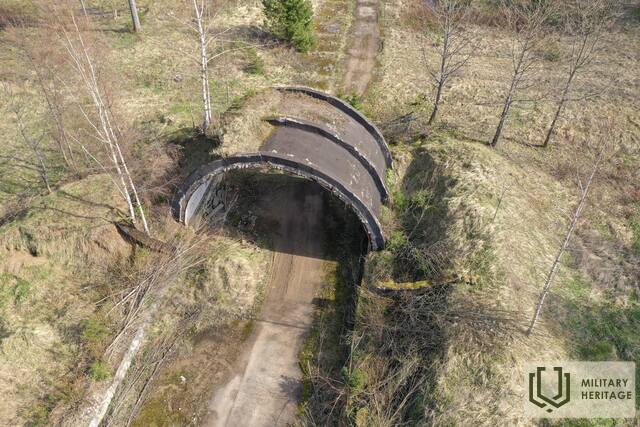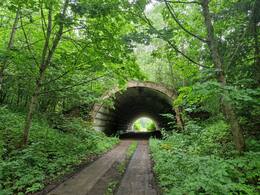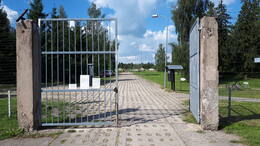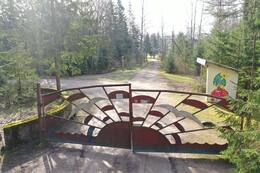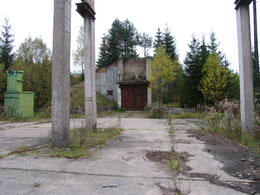In the footsteps of nuclear weapons in Šateikiai Forest
In the period 1960-1978, in the forests of Šateikiai village, in the Plungė district, a ground-based missile launch base operated, where medium-range thermonuclear missiles R12U were deployed. After the missiles were transported, the 384th High-Power Artillery Brigade was deployed at the base. At its disposal were self-propelled 203 mm caliber howitzers 2S7 "Pion" and a variety of other weapons, which cost lives.
According to the story of Silvestras Baumila, a former employee of the Plungė commandant's office, in the Šateikiai Forest, on the territory of a former military unit, there were machines parked in reinforced concrete hangars, and one R12U missile was installed on their platforms. According to the command, those machines were supposed to go to a specified location, and the missiles were launched in the direction of the dictated coordinates.
The missiles from the unit in Šateikiai Forest were removed at the same time as from the Plokštinė missile base. However, in the same territory in Šateikiai, not in reinforced concrete hangars, but in a small reinforced concrete building located further away, fenced off from the outside with several barbed fences, tactical shells with nuclear charges, intended for firing from the “Pions”, were stored. The brigade had at its disposal self-propelled 203 mm caliber howitzers 2S7 “Pion”. Their purpose is to attack the enemy’s rear, destroying important objects at a distance of 47–55 kilometers.
Nuclear-tipped shells may have appeared in Šateikiai at the end of 1981, along with the "Pions". The explosive power of one such shell is estimated at 2 kilotons.
These tactical shells with nuclear warheads could have been transported from Lithuanian territory in July 1992. The Russian Federation's military transport plan for the withdrawal of troops by rail contains information that the chemical assets of the 384th High-Power Artillery Brigade were transported in 36 covered wagons. Most likely, these were nuclear explosives.
In the official report of the Plungė district commandant M. Butkis, dated 15 January 1993, it was written that 24 wagons of explosives stored in Šateikiai had already been loaded. One wagon carried about 20 tons of explosives, a total of about 480 tons of cargo, and permission was given to export 5,425 tons. And this is only about explosives that could be safely transported. However, the warehouses still contained shells left over from World War II, which would have been very dangerous to transport.
According to S. Baumila, a certain business emerged in the Šateikiai Forest, soldiers began selling old explosives to locals. After dismantling them, the brass and copper were sold, and the explosive heads and gunpowder themselves ended up in the Šateikiai Forest. Later, after security was reduced in the area, record-breaking thefts of explosives began at the facility:
"On November 13, 1992, in the territory of the unit, district police and commandant's office employees detained 5 residents of the village of Šateikiai, who had stolen 966 pieces of 5.7 caliber shells... I would like to draw your attention to the fact that various explosives prepared for removal have been found in the forests near the unit," the report continues.
One day, the Plungė commandant's office was informed that a tragic incident had occurred near the village of Šateikiai, in a secluded farm in the forest, in a building where machines were being repaired, with fatalities and injuries. The explosion was caused by detonated explosives. 15 shells used for ship cannons, each weighing 7–8 kilograms, were found at the explosion site. Nearby were machines for dismantling explosives. It was said that 5 people were killed and 9 injured during the incident.
Related timeline
Related objects
Šateikiai ground missile base
In 1960, the Šateikiai Ground Missile Base was built in the forests adjacent to Šateikiai of Plungė district. It was one of four bases of its kind in Lithuania. Four launching pads for R-12 (SS-4 Sandal) medium-range ballistic missiles had been built at the base. Once the signal was received, the missiles could be fired at the European countries of the NATO bloc.
In 1962, during the Caribbean crisis, nuclear missiles were moved from the Šateikiai missile base to central Cuba. The highest level of alert at this base was declared in 1968 during the Prague Spring – the democratic change in Czechoslovakia. At the time, one of the missiles was aimed at the Federal Republic of Germany because the NATO bloc was likely to support the Czechoslovak rebels with its own weapons.
The Šateikiai base was closed in around 1978 because it was considered obsolete and its maintenance – irrational. The closure was also prompted by the fact that by the 1980s it was clear that US intelligence services had identified the locations of stationary missile launch bases. The abandonment of the missile launch site caused structural damage to buildings. The remains of six reinforced concrete warehouses (hangars) are still present on the grounds of the base, as well as bush-covered surface launching pads for rockets.
Šateikiai railway station
Šateikiai railway station is built on the Kužiai-Telšiai-Kretinga railway line in the Plungė district.
In 1918, after the Republic of Lithuania declared its Independence, the formation of railway infrastructure began: an administration system was created, and preparatory courses for railway workers were organized. In 1923, the Cabinet of Ministers decided to build the Kužiai-Telšiai-Kretinga route. The densely populated Samogitia region was chosen, which did not yet have adequate connections with Klaipėda and other centers.
The stations were built after the rail network had already been laid and using standardized architectural designs. The passenger hall of Šateikiai station was built in a typical design, with 1 floor and a roof, and a warehouse was also located in the same building.
During the Cold War, Šateikiai railway station also became important in the military industry. In the period 1960-78, Šateikiai ground-based and Plokštinė underground thermonuclear missile launch bases operated in the Šateikiai and Plokštinė forests. Both during their construction and later, during the period of operation, construction materials, weapons and everything else were transported by train to Šateikiai and Plungė railway stations. It is believed that a huge arsenal of nuclear weapons was deployed at the Šateikiai ground-based base. This is confirmed by the fact that in 1962, missiles were transported to Russia from the Šateikiai ground-based missile base, Šateikiai and Plungė railway stations, and later by ship to Cuba (Cuban Crisis).
Šateikiai railway station currently operates as a regular railway station, with passenger and freight trains arriving and departing. Only fragmentary stories have survived, linking the station's history with the activities of former military missile bases.
Šateikiai railway station
Šateikiai railway station is built on the Kužiai-Telšiai-Kretinga railway line in the Plungė district.
In 1918, after the Republic of Lithuania declared its Independence, the formation of railway infrastructure began: an administration system was created, and preparatory courses for railway workers were organized. In 1923, the Cabinet of Ministers decided to build the Kužiai-Telšiai-Kretinga route. The densely populated Samogitia region was chosen, which did not yet have adequate connections with Klaipėda and other centers.
The stations were built after the rail network had already been laid and using standardized architectural designs. The passenger hall of Šateikiai station was built in a typical design, with 1 floor and a roof, and a warehouse was also located in the same building.
During the Cold War, Šateikiai railway station also became important in the military industry. In the period 1960-78, Šateikiai ground-based and Plokštinė underground thermonuclear missile launch bases operated in the Šateikiai and Plokštinė forests. Both during their construction and later, during the period of operation, construction materials, weapons and everything else were transported by train to Šateikiai and Plungė railway stations. It is believed that a huge arsenal of nuclear weapons was deployed at the Šateikiai ground-based base. This is confirmed by the fact that in 1962, missiles were transported to Russia from the Šateikiai ground-based missile base, Šateikiai and Plungė railway stations, and later by ship to Cuba (Cuban Crisis).
Šateikiai railway station currently operates as a regular railway station, with passenger and freight trains arriving and departing. Only fragmentary stories have survived, linking the station's history with the activities of former military missile bases.
Cold War Exposition
On 31 December 1962, one of the first underground launch complexes for R-12 ballistic missiles in the Soviet Union, the Dvina underground launch complex, was put into operation
in Plokštinė Forest (Plungė district).
Between 1963 and 1978, four R12 medium-range ballistic missiles (SS-4 Sandal) equipped with a 2.3-megatonne nuclear warhead were deployed at the complex. All the missiles were aimed at Western European countries. This complex, together with similar surface-launched missile bases, formed a single Soviet nuclear arsenal in Lithuania, which was capable of destroying the whole of Europe. In its 16 years of operation, not a single missile was fired, despite the declaration of combat readiness during the Prague Spring in 1968.
After the Soviet soldiers left on 18 June 1978, the poorly guarded military facility was vandalised and looted. In 1993, when the complex was handed over to the Žemaitija National Park Directorate, its restoration began. In 2012, the Cold War exposition was opened. Today, this once very secret and guarded place is open to the public. A historical exposition on the Cold War period is on display at the former missile and equipment control room house. To date, it is the only museum in urope where a preserved underground missile launch silo is on display.
Plokštinė Military Town
In 1962, one of the first underground launch complexes for R-12 ballistic missiles in the Soviet Union, the Dvina, was put into operation in Plokštinė Forest (Plungė district).
A military camp was set up 0.5 km from the missile launch site. It occupied an area of 12 hectares, and approximately 30 buildings were built here for various purposes, including residential houses (barracks), officers’ headquarters, two canteens, a boiler house, a power station, a medical post, a club, a pig farm, warehouses, garages, and other structures.
The Plokštinė underground missile launching complex was operational until 18 June 1978. The Soviet soldiers left the area, taking only their weapons with them. In 1979, the management of the former military complex was transferred to the Republican Association of Agricultural Recreation Facilities of Plungė District, and the Plateliai Pioneer Recreation Camp “Žuvėdra” was established at the military campus site. The site was reconstructed and adapted to the needs of the camp, which operated until 1990. After the restoration of Lithuanian independence, the Pioneer Camp was closed.
Since 1993, the site has been managed by the Žemaitija National Park Directorate. In 2017, many of the structures on the military campus were demolished due to their state of disrepair. Today, there are about ten buildings left at the site, and visitors may see them from the outside. Information boards about the former buildings and their functions have been installed.
Nuclear warhead storage (hangar) in Plokštinė
On December 31, 1962, one of the first underground R-12 ballistic missile launch complexes in the Soviet Union, Dvina, began operating in the Plokštīne forests (Plungė district).
From 1963 to 1978, the complex housed 4 medium-range ballistic missiles R12 (SS-4 Sandal), armed with thermonuclear warheads with a yield of 2.3 megatons. All missiles were aimed at Western European countries. This complex, together with ground-based launch bases for similar missiles, formed a single Soviet nuclear weapons group in Lithuania, capable of destroying all of Europe. During the 16 years of operation of the complex, not a single missile was launched, although in 1968, during the Prague Spring, military readiness was declared.
Approximately 0.5 km from the R-12 Dvina nuclear missile launch base, a military camp and a nuclear warhead storage facility (hangar) were built. Very little is known about the purpose of the hangar. It is believed that there were repair shops and a cargo yard here, as well as a hangar where the R-12 thermonuclear missile warheads were probably stored. The hangar is a huge, approximately 60 m long concrete building, covered with a layer of earth on the outside and hidden among the forests.
Currently, the building, like the entire former underground missile launch base, belongs to the Samogitian National Park Directorate. The object is not open to visitors. It cannot be viewed from the inside. However, the building can be viewed from the outside without prior reservation.




